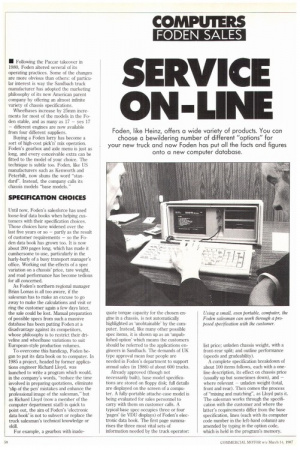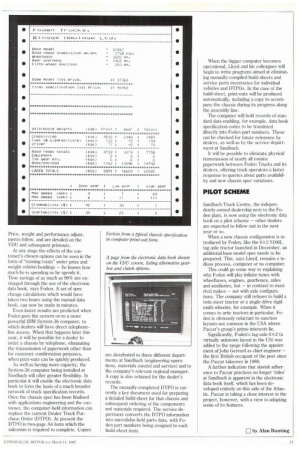SERVICE ON
Page 52

Page 53

If you've noticed an error in this article please click here to report it so we can fix it.
• Following the Paccar takeover in 1980, Foden altered several of its operating practices. Some of the changes are more obvious than others: of particular interest is way the Sandbach truck manufacturer has adopted the marketing philosophy of its new American parent company by offering an almost infinite variety of chassis specifications.
Wheelbases increase by 25mm increments for most of the models in the Foden stable, and as many as 17 — yes 17 — different engines are now available from four different suppliers.
Buying a Foden lorry has become a sort of high-cost pick'n' mix operation. Foden's gearbox and axle menu is just as long, and every conceivable extra can be fitted to the model of your choice. The technique is subtle too. Foden, like US manufacturers such as Kenworth and Peterbilt, now shuns the word "standard". Instead, the company calls its chassis models "base models."
SPECIFICATION CHOICES
Until now, Foden's salesforce has used loose-leaf data books when helping customers with their specification choices. Those choices have widened over the last five years or so — partly as the result of customer requirements — so the Foden data book has grown too. It is now about 200 pages long, which has made it cumbersome to use, particularly in the hurly-burly of a busy transport manager's office. Working out the effects of a spec variation on a chassis' price, tare weight, and road performance has become tedious for all concerned.
As Foden's northern regional manager Brian Lomas is all too aware, if the salesman has to make an excuse to go away to make the calculations and visit or ring the customer again a few days later, the sale could be lost. Manual preparation of possible specs from such a massive database has been putting Foden at a disadvantage against its competitors, whose philosophy is to restrict their driveline and wheelbase variations to suit European-style production volumes.
To overcome this handicap, Foden began to put its data book on to computer. In 1985 a project, headed by former applications engineer Richard Lloyd, was launched to write a program which would, in the company's words, "reduce the time involved in preparing quotations, eliminate 'slip of the pen' mistakes and enhance the professional image of the salesman," but as Richard Lloyd (now a member of the computer department staff) is quick to point out, the aim of Foden's 'electronic data book' is not to subvert or replace the truck salesman's technical knowledge or skill.
For example, a gearbox with inade quate torque capacity for the chosen engine in a chassis, is not automatically highlighted as 'unobtainable' by the computer. Instead, like many other possible spec items, it is shown up as an 'unpublished option' which means the customers should be referred to the applications engineers in Sandbach. The demands of UK type approval mean four people are needed in Foden's department to support annual sales (in 1986) of about 600 trucks.
Already approved (though not necessarily built), base model specifications are stored on floppy disk; full details are displayed on the screen of a computer. A fully-portable attache-case model is being evaluated for sales personnel to carry with them on customer calls. A typical base spec occupies three or four 'pages' (ie VDU displays) of Foden's electronic data book. The first page summarises the three most vital sets of information needed by the truck operator: list price; unladen chassis weight, with a front-rear split; and outline performance (speeds and gradeabifity).
A complete specification breakdown of about 100 items follows, each with a oneline description, its effect on chassis price (usually up but sometimes down), and — where relevant — unladen weight (total, front and rear). Then comes the process of "mixing and matching", as Lloyd puts it. The salesman works through the specification with the customer and where the latter's requirements differ from the base specification, lines (each with its computer code number in the left-hand column) are amended by typing in the option code, which is held in the program's memory. Price, weight and performance adjustments follow, and are detailed on the VDU and subsequent printouts.
At any stage the effects of the customer's chosen options can be seen in the form of "running totals" under price and weight column headings — he knows how much he is spending as he spends it. Time savings of as much as 90% are envisaged through the use of the electronic data book, says Foden. A set of spec change calculations which would have taken two hours using the manual data book, can now be made in minutes.
Even faster results are predicted when Foden puts the system on to a more powerful IBM System-38 computer, to which dealers will have direct telephonefine access. When that happens later this year, it will be possible for a dealer to order a chassis by telephone, eliminating the transmission of paperwork other than for customer comfirmation purposes, when print-outs can be quickly produced.
As well as having more capacity, the System-38 computer being installed at Sandbach will offer greater flexibility. In particular it will enable the electronic data book to form the basis of a much broader network of truck specification records. Once the chassis spec has been finalised with applications engineering and the customer, the computer-held information can replace the current Dealer Truck Purchase Order (DTPO). At present the DTPO is two-page A4 form which the salesman is required to complete. Copies are distributed to three different departments at Sandbach (engineering operations, materials control and service) and to the company's relevant regional manager. A copy is also retained for the dealer's records.
The manually-completed DTPO is currently a key document used for preparing a detailed build-sheet for that chassis and subsequent ordering of the components and materials required. The service department converts the DTPO information into microfiche-held parts data, with Foden part numbers being assigned to each build-sheet item. When the bigger computer becomes operational, Lloyd and his colleagues will begin to write programs aimed at eliminating manually-compiled build-sheets and service parts inventories for individual vehicles and DTPOs. In the case of the build-sheet, print-outs will be produced automatically, including a copy to accompany the chassis during its progress along the assembly line.
The computer will hold records of standard data enabling, for example, data book specification codes to be translated directly into Foden part numbers. These can be checked for future reference by dealers, as well as by the service department at Sandbach.
It will be possible to eliminate physical transmission of nearly all routine paperwork between Foden Trucks and its dealers, offering truck operators a faster response to queries about parts availability and new chassis spec variations.
PILOT SCHEME
Sandbach Truck Centre, the independently-owned dealership next to the Foden plant, is now using the electronic data book on a pilot scheme — other dealers are expected to follow suit in the next year or so.
When a new chassis configuration is introduced by Foden, like the 6x2 S106L tag-axle tractor launched in December, an additional base model spec needs to be prepared. This, says Lloyd, remains a tedious process, computer or no computer.
This could go some way to explaining why Foden will play infinite tunes with wheelbases, engines, gearboxes, axles and auxiliaries, but — in contrast to most rival makes — not with axle configurations. The company still refuses to build a twin-steer tractor or a single-drive rigid multi-wheeler, for example. When it comes to artic tractors in particular, Foden is obviously reluctant to sanction layouts not common in the USA where Paccar's group's prime interests lie.
Significantly, Foden's tag-axle 6x2 (a virtually unknown layout in the US) was added to the range following the appointment of John Gerrard as chief engineer — the first British occupant of the post since the Paccar takeover in 1980.
A further indication that slavish adherence to Paccar practices no longer 'rules' at Sandbach is apparent in the electronic data book itself, which has been developed entirely on this side of the Atlantic. Paccar is taking a close interest in the project, however, with a view to adopting some of its features.




















































































